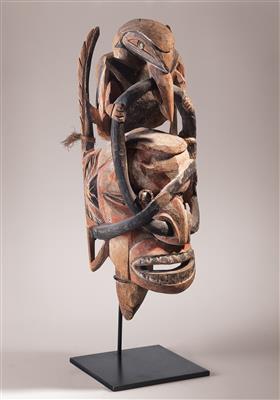An important Malangan head. malaganivis wood, h. 60 cm. 19th century.

These malaganivis were used to transfer power from one generation to the next, and are the essential embodiment of ancestral positions. Only the important and technically difficult sculptures such as malaganivis are made by the tunumar or master carver; a less important mask would be made by the person who would wear it. Because of this importance, these heads display exceptional details. Here the head is surrounded by a primordial being, the Naga serpent. The bird on the head represents the clan as well as the communication with ancestral spirits.
Unlike most Malangan sculptures that were destroyed at the end of each ceremony, the heads were transferred.
Using the intricate style of Malangan sculpture with inner/outer forms, Henri Moore wrote about this discovery: ‚…
New Ireland carvings like this made a tremendous impression on me through their use of forms within a form. I realized what a sense of mystery could be achieved by having the inside partly hidden so that you have to move round the sculpture to understand it. I was also staggered by the craftsmanship needed to make these interior carvings. The carvings of New Ireland have, besides their vicious kind of vitality, a unique spatial sense, a bird-in-a-cage form.‘ (Moore at the British Museum, NY 1981, p. 81.)
Provenance:
Dunrobin Castle, Scotland. Christie’s London, June 19, 1979, lot 221.
Collection estate Baron Freddy Rolin.
Christine Valluet, Paris.
Important Viennese collection.
Specialist: Joris Visser
 Joris Visser
Joris Visser
+32-2-514 00 34
Joris.Visser@dorotheum.com
04.12.2018 - 14:00
- Realized price: **
-
EUR 25,000.-
- Estimate:
-
EUR 8,000.- to EUR 10,000.-
An important Malangan head. malaganivis wood, h. 60 cm. 19th century.
These malaganivis were used to transfer power from one generation to the next, and are the essential embodiment of ancestral positions. Only the important and technically difficult sculptures such as malaganivis are made by the tunumar or master carver; a less important mask would be made by the person who would wear it. Because of this importance, these heads display exceptional details. Here the head is surrounded by a primordial being, the Naga serpent. The bird on the head represents the clan as well as the communication with ancestral spirits.
Unlike most Malangan sculptures that were destroyed at the end of each ceremony, the heads were transferred.
Using the intricate style of Malangan sculpture with inner/outer forms, Henri Moore wrote about this discovery: ‚…
New Ireland carvings like this made a tremendous impression on me through their use of forms within a form. I realized what a sense of mystery could be achieved by having the inside partly hidden so that you have to move round the sculpture to understand it. I was also staggered by the craftsmanship needed to make these interior carvings. The carvings of New Ireland have, besides their vicious kind of vitality, a unique spatial sense, a bird-in-a-cage form.‘ (Moore at the British Museum, NY 1981, p. 81.)
Provenance:
Dunrobin Castle, Scotland. Christie’s London, June 19, 1979, lot 221.
Collection estate Baron Freddy Rolin.
Christine Valluet, Paris.
Important Viennese collection.
Specialist: Joris Visser
 Joris Visser
Joris Visser
+32-2-514 00 34
Joris.Visser@dorotheum.com
|
Buyers hotline
Mon.-Fri.: 10.00am - 5.00pm
kundendienst@dorotheum.at +43 1 515 60 200 |
| Auction: | Tribal Art |
| Auction type: | Saleroom auction |
| Date: | 04.12.2018 - 14:00 |
| Location: | Vienna | Palais Dorotheum |
| Exhibition: | 01.12. - 04.12.2018 |
** Purchase price incl. charges and taxes
It is not possible to turn in online buying orders anymore. The auction is in preparation or has been executed already.
